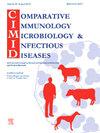乌兹别克斯坦塔什干地区流浪狗和猫中狮弓形虫的患病率、危险因素和系统发育,并说明犬和猫弓形虫的共同感染情况
IF 2
3区 农林科学
Q4 IMMUNOLOGY
Comparative Immunology Microbiology and Infectious Diseases
Pub Date : 2025-04-25
DOI:10.1016/j.cimid.2025.102343
引用次数: 0
摘要
狮子弓形虫是一种影响家养食肉动物的重要寄生虫,对公共卫生具有影响。本研究调查了乌兹别克斯坦塔什干市流浪狗和流浪猫中狮子弓形虫的流行情况、危险因素和系统发育关系,同时调查了犬弓形虫和猫弓形虫的合并感染率。在乌兹别克斯坦塔什干地区进行了一项横断面研究,重点是流浪狗和猫。从2023年2月至2024年9月,收集了180例狗尸体和84例猫尸体进行分析。进行了寄生虫学检查,鉴定了狮子绦虫、犬绦虫和猫绦虫。记录流行病学资料,包括物种、性别、年龄组和采集地点。采用分子分析方法对所选标本进行遗传变异分析,并进行系统发育分析。研究发现,流浪狗和流浪猫的狮子t型绦虫感染率分别为95 %和63.1 %,但两者的共感染模式存在显著差异:78.89 %的狗和28.57 %的猫共感染t型绦虫。值得注意的是,在狗中,不同年龄组的狮子绦虫感染率有统计学意义。遗传分析表明,当地分离株的核苷酸同源性为100% %。系统发育分析表明,在T. leonina组中有四个不同的集群,我们的分离株完全形成一个集群,该集群与感染澳大利亚犬的分离株在遗传上接近。研究结果强调了乌兹别克斯坦塔什干流浪食肉动物中狮子绦虫及其合并感染的监测和控制战略的迫切需要。了解与这些感染相关的遗传多样性和风险因素将有助于制定有效的公共卫生干预措施,并为该区域今后的研究提供信息。本文章由计算机程序翻译,如有差异,请以英文原文为准。
Prevalence, risk factors, and phylogeny of Toxascaris leonina in stray dogs and cats in Tashkent region, Uzbekistan, with a note on co-infection with Toxocara canis and Toxocara cati
Toxascaris leonina is a significant parasitic agent, affecting domestic carnivores, with implications for public health. This study investigates the prevalence, risk factors, and phylogenetic relationships of T. leonina in stray dogs and cats in Tashkent, Uzbekistan, while also examining co-infection rates with Toxocara canis and Toxocara cati. A cross-sectional study was conducted in the Tashkent Region of Uzbekistan, focusing on stray dogs and cats. From February 2023 to September 2024, 180 dog and 84 cat necropsies were collected for analysis. Parasitological examinations were performed to identify T. leonina, T. canis, and T. cati. Epidemiological data, including species, sex, age group, and collection location, were recorded. Molecular analysis was conducted on selected T. leonina specimens to assess genetic variations, and a phylogenetic analysis was performed. The study revealed a high prevalence of T. leonina in stray dogs (95 %) and cats (63.1 %), with significantly different co-infection patterns identified: 78.89 % of dogs were co-infected with T. canis, while 28.57 % of cats had co-infections with T. cati. Notably, in dogs, the infection rate of T. leonina among different age groups was statistically significant. Genetic analysis revealed 100 % nucleotide identity among local T. leonina isolates. The phylogenetic analysis indicated four distinct clusters within the T. leonina group, with our isolates exclusively forming a cluster, which is genetically close to an isolate infecting a dog from Australia. The findings highlight the urgent need for monitoring and control strategies for T. leonina and its co-infections in stray carnivores in Tashkent, Uzbekistan. Understanding the genetic diversity and risk factors associated with these infections will aid in developing effective public health interventions and inform future research in the region.
求助全文
通过发布文献求助,成功后即可免费获取论文全文。
去求助
来源期刊
CiteScore
4.60
自引率
0.00%
发文量
102
审稿时长
40 days
期刊介绍:
Comparative Immunology, Microbiology & Infectious Diseases aims to respond to the concept of "One Medicine" and to provide a venue for scientific exchange. Based on the concept of "Comparative Medicine" interdisciplinary cooperation between specialists in human and animal medicine is of mutual interest and benefit. Therefore, there is need to combine the respective interest of physicians, veterinarians and other health professionals for comparative studies relevant to either human or animal medicine .
The journal is open to subjects of common interest related to the immunology, immunopathology, microbiology, parasitology and epidemiology of human and animal infectious diseases, especially zoonotic infections, and animal models of human infectious diseases. The role of environmental factors in disease emergence is emphasized. CIMID is mainly focusing on applied veterinary and human medicine rather than on fundamental experimental research.

 求助内容:
求助内容: 应助结果提醒方式:
应助结果提醒方式:


